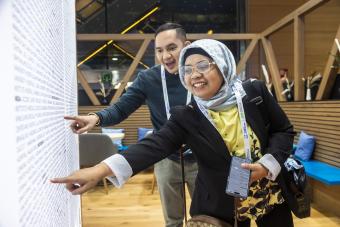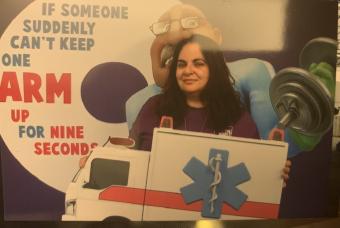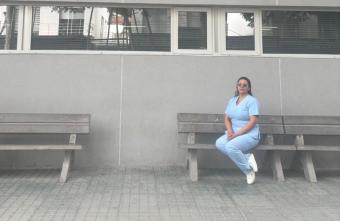Dr Rafael Salazar has 53,400 followers on Instagram, and when you get to the end of this story he will have one more. We dare you to resist searching for @rafaelsalazar2510 or capitulating to his uniquely expressive delivery of emergency medicine content with hashtags #emergencia and his trademark #medicinaenurgencias.
Ditto TikTok. If you have avoided the short-form video-sharing platform until now (because honestly, who has the time), that may be about to change. Same username and hashtags, and you’ll be in excellent company among over 77,200 followers.
Now open Spotify and search among the Rafael Salazars (there are four), for a song entitled “Como Quieres Que Te Quiera” (How do you want me to love you).
Catchy, isn’t it?
You are now in the orbit of Ecuador’s rockstar emergency and disaster physician, head of the emergency service at Hospital Pablo Arturo Suárez in Quito, musician, cycling enthusiast, and natural-born showman who uses social media to save lives.
He’s funny, emphatic, dramatic, intense, and deadly serious about the task at hand – teaching doctors and others how to manage complex medical emergencies such as stroke. “If I teach 20 doctors how to manage stroke, and each of them treats two patients, then I have helped save 40 patients, so they can return home free of disability.”
He also has a common touch – addressing the community in simple language about protecting their health, and using science to combat medical disinformation such as the spurious link between paracetamol and autism recently in the headlines.
“Science is power,” says Rafael, who invests hours of thought and study into what may come across as an off-the-cuff one-minute reel about topics such as septic shock, pulmonary embolism, diabetes, or managing stroke in an emergency room.
As a content creator he is rigorous, conscientious and self-critical – after all, lives are at stake. “Basically I save the lives of many doctors,” he quips. “My life is complicated because my work is to make it very simple for other doctors in the emergency room.”
Going viral
It began almost by chance. The way he tells it, Rafael had been busy recording an album and making TikTok videos about his music when it dawned on him: “Wait, I’m a doctor! So I started to make reels to teach others about managing medical emergencies.”
He didn’t really expect anyone to see them. “I was just Rafael, I had about 200 followers, mostly aunties, uncles, friends and people I knew.”
But four hours after he posted a video about supraventricular arrhythmia, a cousin called and suggested he check his social media.
Two hundred followers had grown to ten thousand and about a thousand more were joining every hour. By the end of the day, Dr Rafael Salazar was a social media influencer with 20,000 followers and counting, with a self-imposed duty to fight disinformation, solve complexity in emergency medicine, and disseminate scientific knowledge too vital to wait for the next congress.
Somewhat famous
Rafael always thought that if people ever wanted his autograph or ask to take pictures with him, it would be because of his music. At the age of five he became interested in his father’s old guitar. “I picked it up, started, and I liked it.”
A contractor who was renovating the family home noticed his interest and offered to become his teacher. And when the second Sunday in March rolled around, five-year-old Rafael astonished his family with a Mother’s Day performance of “A la sombra de mi madre” (In the shadow of my mother).
“They went wow!” he says.
Music is more than a pastime: it is part of his identity. Rafael describes himself as “an artist and a musician who adores the art of storytelling”, but he was equally drawn to medicine, by a love of science, anatomy, and the idea of saving a life.
Being in the emergency room plays to his strengths and suits his temperament. “You have to think fast and I’m good at thinking,” he says. “When a patients first arrives, they may be bleeding, they’re asking for help, then the ER doctor is an angel to this patient. That is the reward, the real reward.
“They may not remember you. When they wake up they will say thank you to all the doctors, but they won’t remember the person who first attended them. But what matters is that you gave the best of you.”
Rafael’s gynaecologist father wasn’t too impressed when he chose emergency as his speciality when a different choice could’ve afforded him a better lifestyle, but it was never about money, Rafael says. “I am interested in saving lives, I’m in medicine to save lives.”
What the two Drs Salazar do agree about, is that being a doctor means being a student for life. “My father always said a doctor studies 25 hours of the day, eight days of the week,” Rafael says.
And that initial disappointment about his choice of specialty no longer causes friction at family gatherings. Quite aside from his social media profile and a leadership role at a top hospital, Rafael is also president of the Ecuadorian Society of Emergency and Disaster Medicine, and a frequent guest on television. His parents are more than proud.
The leader his team needs
In the emergency room there is however no sign of Rafael the internet celebrity. “You need to be quiet, stay calm, use your knowledge,” he says. “You need to be the leader the other doctors and students need, and to take the best decision for the life in front of you.”
To be prepared, he reads a lot. Medical books, so he will feel safe and secure about his knowledge, and philosophy books to help him find the balance between activating knowledge and keeping calm.
In an emergency situation such as stroke, where every second counts, a heightened state of awareness can make events appear to unfold in slow motion. “It may only take 40 minutes,” Rafael says, “but in an experience so intense it feels as if hours have passed before you can breathe again.”
When he goes home, he thinks about what he could have done better in the moment, whether there was another way he could have helped. And when something goes wrong, he studies the case for future opportunities to do better.
It is true of many social media influencers that they follow few accounts themselves, or even apply a “follow nobody” rule. Their priority is to stay focused on their own narrative; they prefer to be broadcasters rather than consumers of content.
But not Dr Rafael Salazar. He follows: doctors he thinks are leaders (because he likes to learn); company CEOs; musicians, of course; poets; sports leaders including his idol Richard Carapaz (the first Ecuadorian to win a major international cycling event), and accounts dedicated to boxing, independent cinema and art.
He follows “people who transcend lines”, Rafael says. He seeks inspiration from people who move beyond established boundaries and challenge conventional thinking – the same reasons in other words why following @rafaelsalazar2510 may be the next thing you do.
Transforming lives and leaving a legacy
“When I started in emergency medicine, treating a patient with suspected stroke was like a highway under construction: there was no infrastructure, resources were limited, and the prognosis depended more on willpower than on available tools. The arrival of Angels marked a turning point.
With their support, we were able to organize the stroke team, structure care pathways, and build the necessary network to make treatment a reality rather than just a hope. But we quickly understood that none of this makes sense without one essential pillar: continuous education for emergency personnel.
From that moment on, the challenges grew. It was no longer just about training those of us working inside the hospital, but also about educating the community and decision-makers. That’s why social media became a strategic tool: it allows us to reach three key actors — the general population, healthcare professionals, and authorities — to talk about prevention, critical timing, and real public health.
Today, our team feels supported, protected, and confident in what we do. The community trusts that it has a center capable of responding to stroke with timeliness, effectiveness, and truth. This work is just beginning to take root, but it has already changed the landscape. What used to be uncertainty is now a project with future and purpose.
The goal is clear: less disability, earlier diagnosis, more trained physicians, and more lives recovered. And for future generations to continue this path hand in hand with Angels.
My gratitude runs deep for Angels, for Eduardo Moncayo, for Erika Bermeo, and for every person on the team who has accompanied this process with consistency, generosity, and quiet commitment. Their support not only strengthens emergency services — it transforms lives and leaves a legacy.”
– Dr Rafael Salazar


